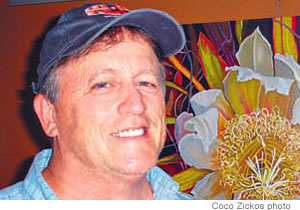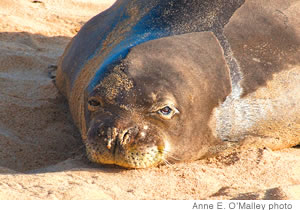The Monk Seals’ Best Friend On Kaua‘i

Timothy Robinson, project coordinator for Kaua‘i Monk Seal Watch Program
Timothy Robinson works tirelessly to save the endangered Hawaiian monk seal from extinction – and he’s teaching others to do the same
Expressions of serenity as they bask in the sun with flippers draped over their bellies might be reason enough to want to prevent the Hawaiian monk seal from going extinct, but for Timothy Robinson there is so much more to the marine mammal than simply its cuteness.
Because the ancient species plays such a vital role in the ocean environment, Robinson has dedicated more than a decade of his life helping to spread awareness about the critically endangered seal.
“They sit near the top of the food chain, and since they are in severe decline, they are a bellwether of the health of our oceans,” says Robinson, project coordinator of the nonprofit Kaua’i Monk Seal Watch Program. “By teaching people how to protect and nurture their existence, we’re also helping our entire marine ecosystem to help sustain ourselves.”
It is thanks to the perseverance of individuals like Robinson that these sea creatures can still be seen dotting Kauai’s coastline – often appearing to the untrained eye as large rocks while they lie in slumber, gearing up for an evening of foraging.
“It’s like I finally found something I’m really interested in,” he says. “I love the ocean, I love wildlife, and so when you find something you love to do, it makes it easy. Everybody can find something they’re good at.”

A Hawaiian monk seal languishes on shore
Robinson joined the nonprofit, which was originally formed by a group of concerned citizens as an adjunct of the state Department of Land and Natural Resources, in July 2000 after the first high-profile monk seal birth on island.
Often putting in more hours than required of a full-time job to promote the welfare of the seals, Robinson’s primary focus is educational outreach.
For the past 10 years, Robinson has been instrumental in teaching some 10,000 students across the island about the seals.
Each year, fourth-grade students on Kauai and now on Molokai are treated to hourlong presentations that consist of shared facts about the monk seals and the environment in which they thrive, with an added focus on the detriment of marine debris.
“I never envisioned myself as a teacher, but I took to it pretty well. There’s no greater joy than seeing young kids learn and get excited about the monk seals and want to save them,” he says.
Not only does Robinson spend several weeks of the year teaching fourth-graders about the seals, he also takes regular trips to resorts such as Sheraton Kaua’i Resort and Westin Princeville Ocean Resort Villas to help educate visitors.
“The presentations allow visitors who are interested to come and learn,” he says about the nearly 5,000 travelers who’ve attended the presentations since 2006. “And they love it; they usually linger and ask questions.”
Education, hopefully, will help to avoid incidents like the ones last year when two monk seals on Kauai were killed. The individual(s) responsible for the slaying of the juvenile male seal at Kaumakani have yet to be identified and a reward $10,000 is still being offered for information that could lead to the arrest and conviction of the guilty person(s). Charles Vidinha, a 78-year-old Anahola resident, was found guilty of shooting a pregnant female in April 2009 at Pila’a Beach on the North Shore. He was sentenced to 90 days in prison.
“The murders of the seals last year were indeed tragic,” Robinson said. “While I understand the hunting or culling of over-populated species, I will likely never understand how an individual can become so utterly depraved he/she would kill one of such a critically endangered species.”
However, there is a way to turn a negative situation into a positive. The multiple killings ultimately led to stiffer penalties passed through the state Legislature this year, which include changing the endangerment of a monk seal from a misdemeanor to a felony.
“I think what the murders really enforced for me was the vital importance of our educational work,” Robinson says. “Consistent, comprehensive, long-term education of our children is the only hope to eliminate behavior like this down the line.”
When Robinson first began his volunteer work with the nonprofit, there were some 20 seals regularly traversing the island. Now there are approximately 35 to 40. Overall, some 1,100 Hawaiian monk seals are believed to be in existence throughout the Hawaiian archipelago.
“The effort has to be constant and well-planned,” he says. “And this is the most important thing I can do with my time right now.”
A self-proclaimed citizen of the world, Robinson calls Kaua’i his home base, and since he grew up with the knowledge that one must give back to his community in a way he feels passionately about, he immediately took to the seals.
“I feel like they are survivors,” he says regarding his adoration for the endangered species. “The most critical thing going on in our lives is the environment. We can’t destroy the oceans – that’s where all life comes from.”
And even though he has never made a dime, sometimes working up to 60 hours a week, Robinson says he would not trade a minute of it:
“I love what I do.”
You must be logged in to post a comment.




There are no comments
Add yours